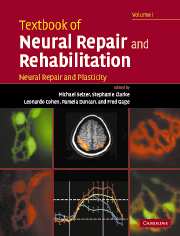Book contents
- Frontmatter
- Contents
- Contents (contents of Volume II)
- Preface
- Contributors (contributors of Volume I)
- Contributors (contributors of Volume II)
- Neural repair and rehabilitation: an introduction
- Section A Neural plasticity
- Section A1 Cellular and molecular mechanisms of neural plasticity
- Section A2 Functional plasticity in CNS system
- Section A3 Plasticity after injury to the CNS
- Section B1 Neural repair
- 16 Neuronal death and rescue: neurotrophic factors and anti-apoptotic mechanisms
- 17 Axon degeneration and rescue
- 18 Adult neurogenesis and neural precursors, progenitors, and stem cells in the adult CNS
- 19 Axon guidance during development and regeneration
- 20 Synaptogenesis
- Section B2 Determinants of regeneration in the injured nervous system
- Section B3 Promotion of regeneration in the injured nervous system
- Section B4 Translational research: application to human neural injury
- Index
17 - Axon degeneration and rescue
from Section B1 - Neural repair
Published online by Cambridge University Press: 05 March 2012
- Frontmatter
- Contents
- Contents (contents of Volume II)
- Preface
- Contributors (contributors of Volume I)
- Contributors (contributors of Volume II)
- Neural repair and rehabilitation: an introduction
- Section A Neural plasticity
- Section A1 Cellular and molecular mechanisms of neural plasticity
- Section A2 Functional plasticity in CNS system
- Section A3 Plasticity after injury to the CNS
- Section B1 Neural repair
- 16 Neuronal death and rescue: neurotrophic factors and anti-apoptotic mechanisms
- 17 Axon degeneration and rescue
- 18 Adult neurogenesis and neural precursors, progenitors, and stem cells in the adult CNS
- 19 Axon guidance during development and regeneration
- 20 Synaptogenesis
- Section B2 Determinants of regeneration in the injured nervous system
- Section B3 Promotion of regeneration in the injured nervous system
- Section B4 Translational research: application to human neural injury
- Index
Summary
Introduction
In the mid-19th century Augustus Waller found that the distal stump of a severed axon underwent degeneration, while the axon proximal to the site of injury survived (Waller, 1850). Waller's seminal contribution was made in England only 2 years after Schleiden and Schwann articulated the cell theory in 1848. It had previously been recognized that following transection of a nerve, the muscles were paralyzed. Waller brought to such experiments the advent of microscopy. In the frog hypoglossal nerve he observed that distal to the site of section the fibers survived for only a few days, then degenerated so that the “axis cylinders” – the axons – disappeared (Waller, 1850). Proximal to the site of section they survived.
Implicit in the findings of Waller the idea that the nerve cell body is a nutritive source for the axon, without which the axon can only survive for short periods. This observation identified the nerve cell body as the “nourishing mother” of a dependent axon, and suggested that the separation of the severed axon from the cell body resulted in passive starvation of the axon. Waller's inferences have proved largely correct: most macromolecular synthesis occurs largely in the nerve cell body, so that the axon is largely a metabolically dependent structure. Yet the inescapable lesson of the last two decades of research is that Wallerian degeneration is not passive, but an energy-requiring, temperature-sensitive active process of self-destruction, conceptually analogous to apoptotic mechanisms of cell death (see Volume I, Chapter 16).
Keywords
- Type
- Chapter
- Information
- Textbook of Neural Repair and Rehabilitation , pp. 293 - 302Publisher: Cambridge University PressPrint publication year: 2006



